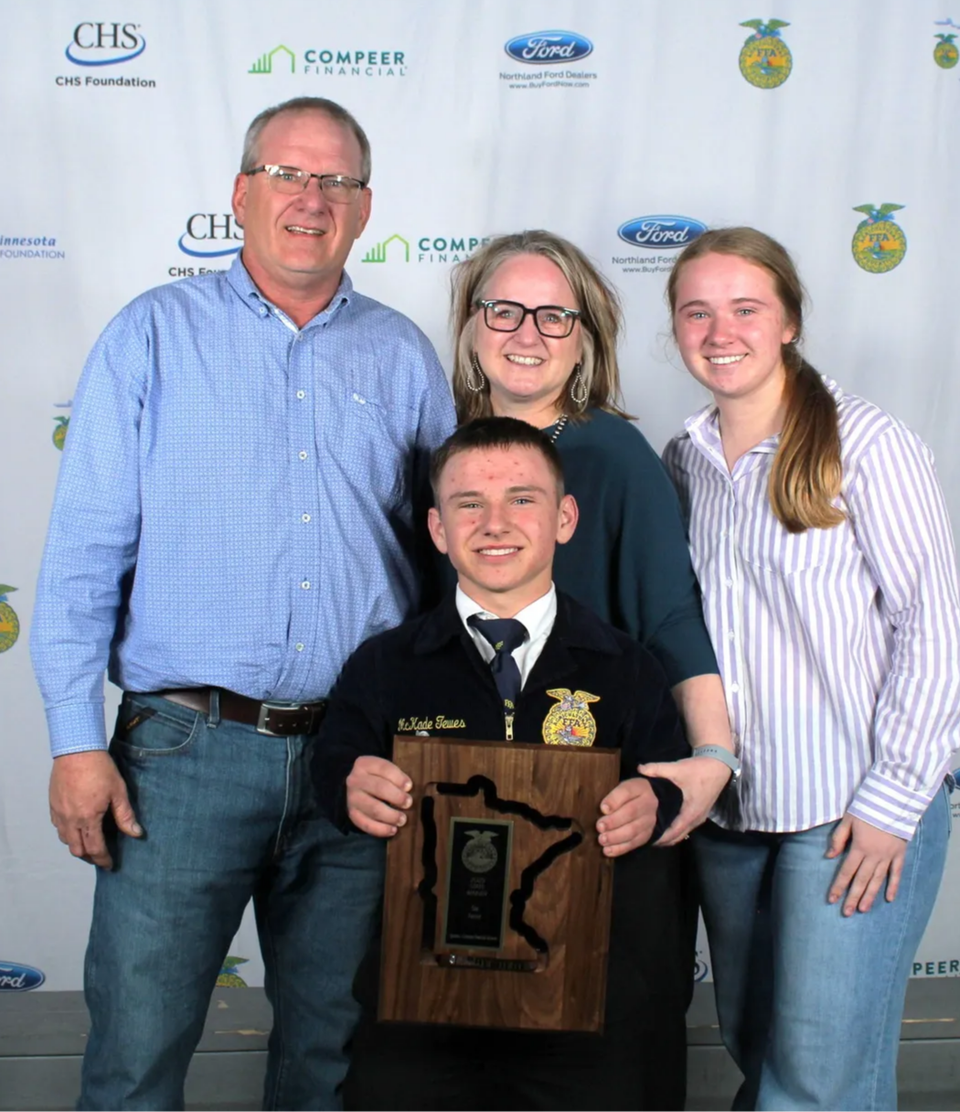Tewes a rising star in the beef industry

By Justin R. Lessman
McKade Tewes of rural Jackson is a rising star in the beef industry.
And he’s got the hardware to prove it.
Tewes, son of Jeff and Jen Tewes and a senior at Jackson County Central High School in Jackson, was named Minnesota FFA Star Farmer at the Minnesota State FFA Convention in Minneapolis late last month. The star farmer award is one of four top individual designations given to Minnesota FFA members, with star awards also given in categories of production placement; agriculture, food and natural resource sciences; and agribusiness.
Tewes plays a vital role in his family operation, Tewes Cattle Co., where he purchases cattle and embryos to develop his own show herd, in addition to completing daily chores, administering medications and overseeing sales of cattle.
Though he grew up on a 100-head cattle farm, Tewes traces his own involvement in the business to a grant he received in 2021 through Security State Bank’s Junior Herdsman Project. The grant facilitated the purchase of five bred heifers, which Tewes said kickstarted his own cattle herd and led him to start his own business.
“I started Tewes Cattle Co. my freshman year of high school,” he said. “Now, I breed with embryos and live cattle to build the quality and quantity of my herd. I use an embryo transfer program to raise show cattle that will be marketed at a national level.”
Part of his marketing strategy is showing his own cattle. Last year, Tewes exhibited the reserve champion breeding heifer and reserve champion market steer at the Jackson County Fair’s 4-H beef show and earned a purple ribbon with his registered black Angus summer yearling at the Minnesota State Fair’s 4-H beef show.
Tewes has a long history with the FFA organization. He competes in the livestock evaluation career development event and parliamentary procedure leadership development event and has served as a chapter officer.
Outside of the FFA, Tewes is also an active member of his school and community. He volunteers with the local Foods 4 Kids effort, at local food shelves and with ditch cleanup efforts and is an active member of the National Honor Society and local 4-H club and 4-H livestock judging team.
In the future, Tewes plans to become an embryologist within the field of livestock genetics.
“I plan to attend Butler Community College next year to major in animal science and compete on the livestock judging team,” he said.
In addition to being named 2025 Minnesota FFA Star Farmer at this year’s Minnesota State FFA Convention, Tewes also received his state FFA degree. He credits his success in FFA — and in life — in large part to his FFA advisors past and present, his parents and his sister, Meta.
McKade Tewes of rural Jackson is a rising star in the beef industry.
And he’s got the hardware to prove it.
Tewes, son of Jeff and Jen Tewes and a senior at Jackson County Central High School in Jackson, was named Minnesota FFA Star Farmer at the Minnesota State FFA Convention in Minneapolis late last month. The star farmer award is one of four top individual designations given to Minnesota FFA members, with star awards also given in categories of production placement; agriculture, food and natural resource sciences; and agribusiness.
Tewes plays a vital role in his family operation, Tewes Cattle Co., where he purchases cattle and embryos to develop his own show herd, in addition to completing daily chores, administering medications and overseeing sales of cattle.
Though he grew up on a 100-head cattle farm, Tewes traces his own involvement in the business to a grant he received in 2021 through Security State Bank’s Junior Herdsman Project. The grant facilitated the purchase of five bred heifers, which Tewes said kickstarted his own cattle herd and led him to start his own business.
“I started Tewes Cattle Co. my freshman year of high school,” he said. “Now, I breed with embryos and live cattle to build the quality and quantity of my herd. I use an embryo transfer program to raise show cattle that will be marketed at a national level.”
Part of his marketing strategy is showing his own cattle. Last year, Tewes exhibited the reserve champion breeding heifer and reserve champion market steer at the Jackson County Fair’s 4-H beef show and earned a purple ribbon with his registered black Angus summer yearling at the Minnesota State Fair’s 4-H beef show.
Tewes has a long history with the FFA organization. He competes in the livestock evaluation career development event and parliamentary procedure leadership development event and has served as a chapter officer.
Outside of the FFA, Tewes is also an active member of his school and community. He volunteers with the local Foods 4 Kids effort, at local food shelves and with ditch cleanup efforts and is an active member of the National Honor Society and local 4-H club and 4-H livestock judging team.
In the future, Tewes plans to become an embryologist within the field of livestock genetics.
“I plan to attend Butler Community College next year to major in animal science and compete on the livestock judging team,” he said.
In addition to being named 2025 Minnesota FFA Star Farmer at this year’s Minnesota State FFA Convention, Tewes also received his state FFA degree. He credits his success in FFA — and in life — in large part to his FFA advisors past and present, his parents and his sister, Meta.


